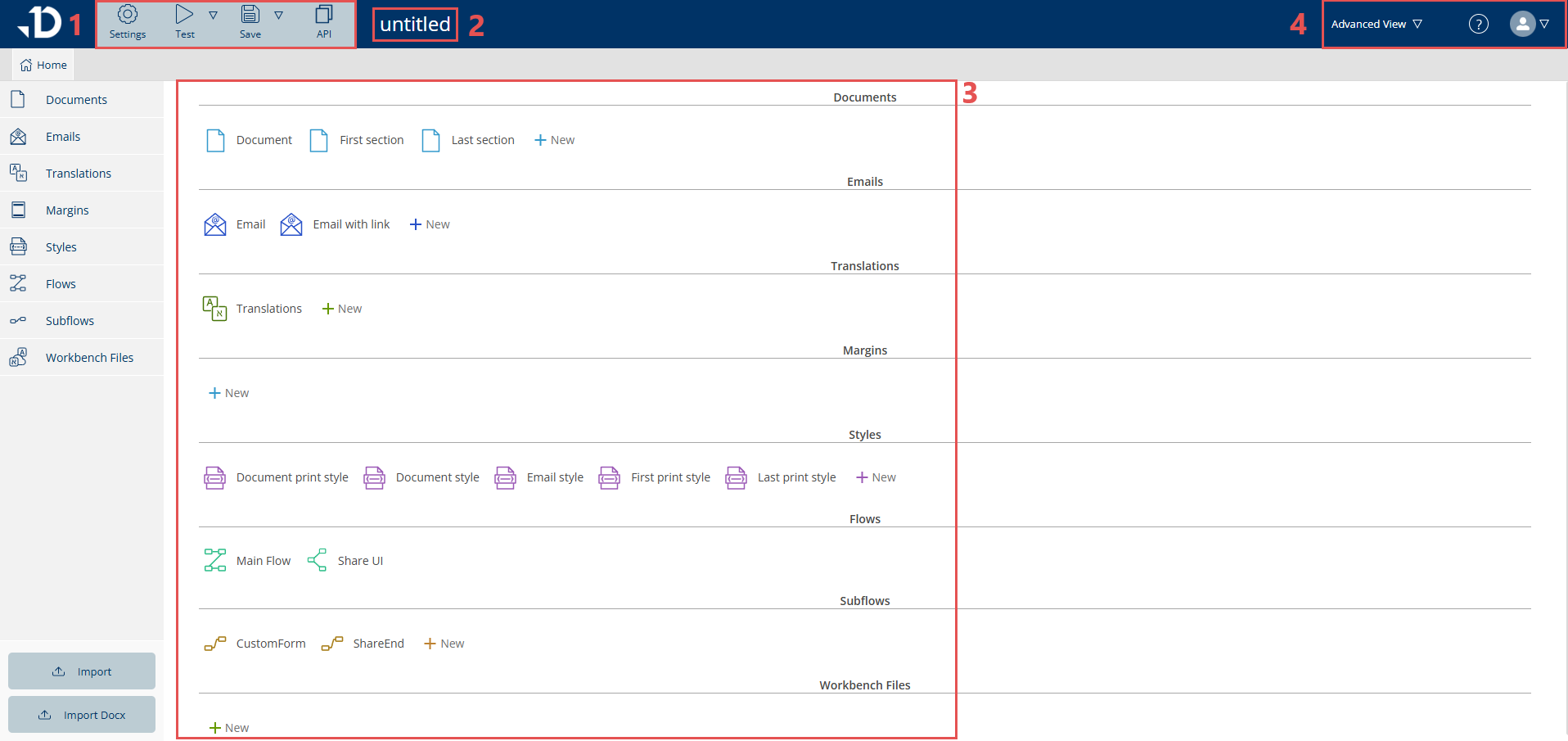The Home View is accessible by switching to Advanced View and clicking on “Home” in the left hand upper corner. It is home to all the settings and configurations that operate in the background of the template:
The document sections displayed in the Home tab will vary depending on the type of template being used.

1. Buttons
-
Settings: Configure the general flow of the template, such as enable editing, or sending email workflow. More details on Settings
-
Test: Test the template with a selected Salesforce record to preview the layout before releasing final changes
-
Save: Save the template, create a .dap file or update an existing file in Salesforce
-
Release: saves the changes made as a separate template file which can be used by the end-user. This allows users to manage two template versions from the same template file. For example, use the save button when performing testing and then use “Release” when the new version is ready for end-users.
-
API: to manually trigger running the template to test the API call connection (task and result) is working
2. Template Title
The template title can be modified when saving the first time or renamed by editing details in Salesforce > Files.
3. Home Tab
Documents
A full document is built from sections: first, main and last. Sections have their own header and footer and page orientation. At least one section should be included in the final document. Section templates can be further configured in Settings.
Document
This is the main document content template. Template editing is done through the document template editor. The document template defines document layout (header, body, footer), content and style (together with style part).
The document template is divided to header, body and margin areas. Clicking each area will change the editing focus to the selected area.
First section
The first section document template defines how the first section of the full document looks. It can be used to define a cover page, for example, that uses a different page layout than the rest of the document. Content length determines if it is one page or several pages in the PDF output.
By default, the first section is included in the full document. The first section can be removed from Settings: Document - Templates - First: none.
Last section
The last document template defines how the document’s last section is built. It can be used to differentiate the last page(s) of the document if for example the last page should have a header/footer different from the rest of the document.
The last section is not included by default in the full document. It can be included from Settings: Document - Templates - Last: Last/content.html
Email
Email
If the process requires an email to be sent, this is where the email layout is designed. Emails are used to either:
-
send an email with the composed document as an attachment;
-
or, skip composing a document and just send an email (this is widely used by companies to manage case and ticketing correspondence, for example).
Email with link
When using an external workflow, the document will be sent out as a link instead of an attachment. The Email with link template can be used to create customized email templates already containing the document link.
Translations
If the process requires multiple languages, this is where the translations are managed.
Styles
This includes Document or Email Style details. Whenever a new style is added while editing the template, a new style entry will be added here to achieve an overview of all Styles used.
Workflow
There are two main types of workflow:
-
Main flow defines Dynamo template’s logic, contains variable definition and data processing using step commands and screens. Commands can be auto generated while working with Settings or through the Template Editor. It can also be manually added by the authors.
-
Share UI defines common template to be using for external workflows. Typically, this does not require any user modifications.
-
Sub flow can be used to manage repeatable processes within a Main flow, for example.
-
CustomForm is used to enable the Form screen. This screen will be presented to the user before a document is generated and can be used to collect additional information such as the document’s language. Learn more about Flow screens here: Screen Edit View Basics
-
ShareEnd is used to execute commands after the document has been shared externally, such as for e-signatures. A common use-case is updating a Salesforce record after a document has been signed.
-
4. Template Support
-
Allows Switching UI (User Interface) mode between Basic and Advanced;
-
Quick access to Help Center;
-
Logout or switch account to another user/another org.
